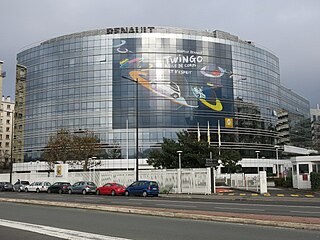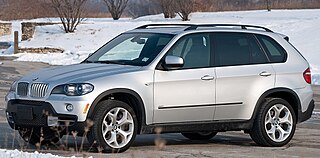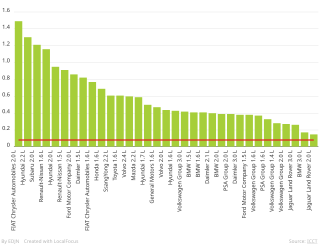Related Research Articles

Groupe Renault is a French multinational automobile manufacturer established in 1899. The company produces a range of cars and vans and in the past, has manufactured trucks, tractors, tanks, buses/coaches, aircraft and aircraft engines, and autorail vehicles.

A catalytic converter is an exhaust emission control device which converts toxic gases and pollutants in exhaust gas from an internal combustion engine into less-toxic pollutants by catalyzing a redox reaction. Catalytic converters are usually used with internal combustion engines fueled by gasoline or diesel, including lean-burn engines, and sometimes on kerosene heaters and stoves.
Vehicle emissions control is the study of reducing the emissions produced by motor vehicles, especially internal combustion engines. The primary emissions studied include hydrocarbons, volatile organic compounds, carbon monoxide, carbon dioxide, nitrogen oxides, particulate matter, and sulfur oxides. Starting in the 1950s and 1960s, various regulatory agencies were formed with a primary focus on studying the vehicle emissions and their effects on human health and the environment. As the worlds understanding of vehicle emissions improved, so did the devices used to mitigate their impacts. The regulatory requirements of the Clean Air Act, which was amended many times, greatly restricted acceptable vehicle emissions. With the restrictions, vehicles started being designed more efficiently by utilizing various emission control systems and devices which became more common in vehicles overtime.

Emission standards are the legal requirements governing air pollutants released into the atmosphere. Emission standards set quantitative limits on the permissible amount of specific air pollutants that may be released from specific sources over specific timeframes. They are generally designed to achieve air quality standards and to protect human life. Different regions and countries have different standards for vehicle emissions.

Exhaust gas or flue gas is emitted as a result of the combustion of fuels such as natural gas, gasoline (petrol), diesel fuel, fuel oil, biodiesel blends, or coal. According to the type of engine, it is discharged into the atmosphere through an exhaust pipe, flue gas stack, or propelling nozzle. It often disperses downwind in a pattern called an exhaust plume.

The BMW E70 is the second-generation BMW X5 mid-size luxury SUV. It replaced the BMW X5 (E53) in July 2006. It was manufactured alongside the BMW X6 at BMW's Greer, South Carolina plant in the U.S. and BMW's facility in Toluca, Mexico.

On-board diagnostics (OBD) is a term referring to a vehicle's self-diagnostic and reporting capability. In the United States, this self-diagnostic is a requirement to comply with Federal Emissions standards to detect failures that may increase the vehicle tailpipe emissions to more than 150% of the standard to which it was originally certified.
The New European Driving Cycle (NEDC) was a driving cycle, last updated in 1997, designed to assess the emission levels of car engines and fuel economy in passenger cars. It is also referred to as MVEG cycle.

The European emission standards are vehicle emission standards for pollution from the use of new land surface vehicles sold in the European Union and European Economic Area member states and the United Kingdom, and ships in EU waters. The standards are defined in a series of European Union directives staging the progressive introduction of increasingly stringent standards.

A portable emissions measurement system (PEMS) is a vehicle emissions testing device that is small and light enough to be carried inside or moved with a motor vehicle that is being driven during testing, rather than on the stationary rollers of a dynamometer that only simulates real-world driving.
United States vehicle emission standards are set through a combination of legislative mandates enacted by Congress through Clean Air Act (CAA) amendments from 1970 onwards, and executive regulations managed nationally by the Environmental Protection Agency (EPA), and more recently along with the National Highway Traffic Safety Administration (NHTSA). These standard cover common motor vehicle air pollution, including carbon monoxide, nitrogen oxides, and particulate emissions, and newer versions have incorporated fuel economy standards.

Jaguar Land Rover Automotive PLC is the holding company of Jaguar Land Rover Limited, also known as JLR, and is a British multinational automobile manufacturer which produces luxury vehicles and sport utility vehicles. It is a subsidiary of Tata Motors and has its head office in Whitley, Coventry, UK. The principal activity of Jaguar Land Rover Limited is the design, development, manufacture and sale of vehicles bearing the Jaguar and Land Rover marques.
Bharat stage emission standards (BSES) are emission standards instituted by the Government of India to regulate the output of air pollutants from compression ignition engines and Spark-ignition engines equipment, including motor vehicles. The standards and the timeline for implementation are set by the Central Pollution Control Board under the Ministry of Environment, Forest and Climate Change.

The Jaguar XE (X760) is a car manufactured by Jaguar Land Rover and marketed under their Jaguar marque since April 2015. A large family car, it has a four-door saloon car body style and is aimed at the compact-executive market segment. It is front engined and sold with both rear-wheel drive and all-wheel drive. The successor to the X-Type, it was designed by Ian Callum and launched at the October 2014 Paris Motor Show.
The Worldwide harmonized Light vehicles Test Procedure (WLTP) is a global driving cycle standard for determining the levels of pollutants, CO2 emission standards and fuel consumption of conventional internal combustion engine (ICE) and hybrid automobiles, as well as the all-electric range of plug-in electric vehicles.

The Volkswagen emissions scandal, sometimes known as Dieselgate or Emissionsgate, began in September 2015, when the United States Environmental Protection Agency (EPA) issued a notice of violation of the Clean Air Act to German automaker Volkswagen Group. The agency had found that Volkswagen had intentionally programmed turbocharged direct injection (TDI) diesel engines to activate their emissions controls only during laboratory emissions testing, which caused the vehicles' NOx output to meet US standards during regulatory testing. However, the vehicles emitted up to 40 times more NOx in real-world driving. Volkswagen deployed this software in about 11 million cars worldwide, including 500,000 in the United States, in model years 2009 through 2015.

A defeat device is any motor vehicle hardware, software, or design that interferes with or disables emissions controls under real-world driving conditions, even if the vehicle passes formal emissions testing. The term appears in the US Clean Air Act and European Union regulations, to describe anything that prevents an emissions control system from working, and applies as well to power plants or other air pollution sources, as to automobiles.

The Jaguar I-Pace is a battery-electric crossover SUV produced by Jaguar Land Rover (JLR) under their Jaguar marque. The I-Pace was announced in March 2018, European deliveries began in June 2018 and North American deliveries started in October 2018. Amid slowing sales and a change in corporate vision, Jaguar has announced that the I-Pace will be discontinued by 2025.

From 2014 onwards, software which manipulated air pollution tests was discovered in vehicles from some car makers; the software recognized when the standardized emissions test was being done, and adjusted the engine to emit less during the test. The cars emitted much higher levels of pollution under real-world driving conditions. Some cars' emissions were higher even though there was no manipulated software.
Green NCAP is a green vehicle assessment programme hosted and supported by the European New Car Assessment Program in cooperation with European Governments. The Organisation has test laboratories in eight European countries and aims to increase awareness of the environmental impact of the vehicles. The first set of results was released on 28 February 2019.
References
- ↑ "Contact Us". AIR. Retrieved 7 March 2019.
- 1 2 3 Ogden, Chris (28 February 2019). "AIR alliance launches new vehicle emissions ranking system". airqualitynews.com. Retrieved 7 March 2019.
- 1 2 3 "Air Index launches on-road, independent guide to tailpipe emissions". FleetNews. 28 February 2019. Retrieved 7 March 2019.
- 1 2 3 4 Aucock, Richard (28 February 2019). "Land Rover excels in new car NOx emissions AIR index – but Renault slammed". Motoring Research. Retrieved 7 March 2019.
- 1 2 3 4 Shale-Hester, Tristan (28 February 2019). "New AIR Index car emissions system launches with red, amber and green ratings". AutoExpress. Retrieved 7 March 2019.
- ↑ "JLR tests new cars with AIR index, new diesel engines among cleanest for NOx emissions". Professional Autocar. 7 March 2019. Retrieved 7 March 2019.